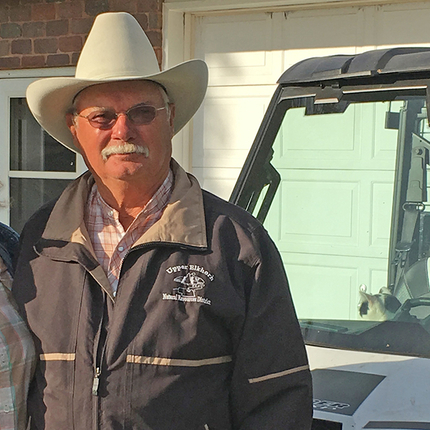By Becky Keim, former staff member
Located near the headwaters of the Elkhorn River, the Stewart Hereford Ranch sits on 13,000 acres in the Sandhills outside of Newport, Neb. The ranch is owned by Roy and June Stewart and their son and daughter-in-law, Jay and Kaye Stewart, who also manage the operation.
The ranch includes a biologically diverse mix of sub-irrigated meadows and sandhill pastures, which require a conservation mindset, according to its owners.
After purchasing the ranch in 1978, Roy began a series of conservation efforts designed to positively impact the health and profitability of his ranch over the long term. He planted more than 37,000 trees on the property, put wildlife escape ramps and overflows on all water tanks, used prescribed grazing practices, planted woody buffer strips with berry bushes, plums, chokecherries and other trees, and installed cross-fencing, among other efforts.
According to Roy, conservation is an important part of good grassland management.
“If you don’t do a good job of managing, you won’t get the best return, and you have to work with mother nature and not against her,” he said.
This dynamic outlook on stewardship of the land and conservation practices led Roy’s neighbor to nominate the Stewart Hereford Ranch for the Master Conservation Award for Nebraska, which they won in 1986.
Today, Jay and Kaye live on the ranch with their family, and conservation remains a priority. Their largest and most recent conservation project included a stream restoration project completed in spring 2014.
Before Roy purchased the ranch, an upper section of the stream was straightened to create easier access to the meadows for haying. Unfortunately, over time, the straightening of the streambed, in combination with other factors, deepened the streambed and created a loss of wetland hydrology and grass species in the sub-irrigated meadows.
In 2007, after noticing continued degradation and erosion along the streambed, Roy contacted a Natural Resources Conservation Service (NRCS) area agricultural engineer to discuss ways to raise water levels in the streambed while simultaneously improving the hydrology of the sub-irrigated meadows the Stewarts rely on for hay production for their cattle.
The conservation solution involved several partners, including NRCS, the Sandhills Task Force and Nebraska Game and Parks. The partners helped to install four water control structures, including a weir and three rock cross vanes (to minimize bank erosion, among other things), an earth embankment (to allow Roy to lower the water level for maintenance and haying) and reconstructed stream meanders (to increase the length and reduce downcutting of the channel during high runoff and intense rainfall events).
After completion of the project, the structures proved successful not only in raising water levels and improving the hydrology of sub-irrigated meadows, but also in successfully reducing sediment transport, providing flood protection downstream, and returning the former wet meadows back to their historic production.
While it may take a while to recover the costs of the project, even with the partner cost-share, Roy is confident the restoration project was the right decision. Prior to the stream restoration, “there was just no production, you could see your sickles out there when you mowed, there just wasn’t anything there to mow… now it’s probably producing two tons to the acre.”
In addition to increased production, the restoration project created additional wetland habitat, making the ranch a more desirable spot for migrating birds and other wildlife.
“We’ve increased hay production and vegetation production,” Roy said. “Of course, whenever you do that there’s more habitat there.”
Roy and June notice more geese, deer and even a few whooping cranes and swans in the area, which were never on the ranch before.
Roy plans to plant more trees on the property and may consider additional conservation practices. At the Stewart Hereford Ranch, it’s important to be proactive in terms of addressing any issues on the land and educating yourself on the various conservation practices out there.
For Roy and June, this means traveling the world, with trips to Argentina, Australia and, most recently, Uruguay, where they visited ranches and viewed various conservation practices first hand.
“I always come home with a new idea or something that I can put in place here,” Roy said. “Somebody’s always got something that works better, and that’s what I’m looking for.”
Conservation is important to the Stewart family, not only for the economic benefits derived by improving the land, but also for the greater satisfaction of stewarding the grassland prairies of our nation. According to Roy, “this is God’s own country, and we’d like to keep it that way.”
Featured photo: Ranchers and conservationists, Roy Stewart and June Stewart, on their biologically diverse ranch. The couple and their son and daughter-in-law raise Herefords in the Nebraska Sandhills. | Photo submitted





